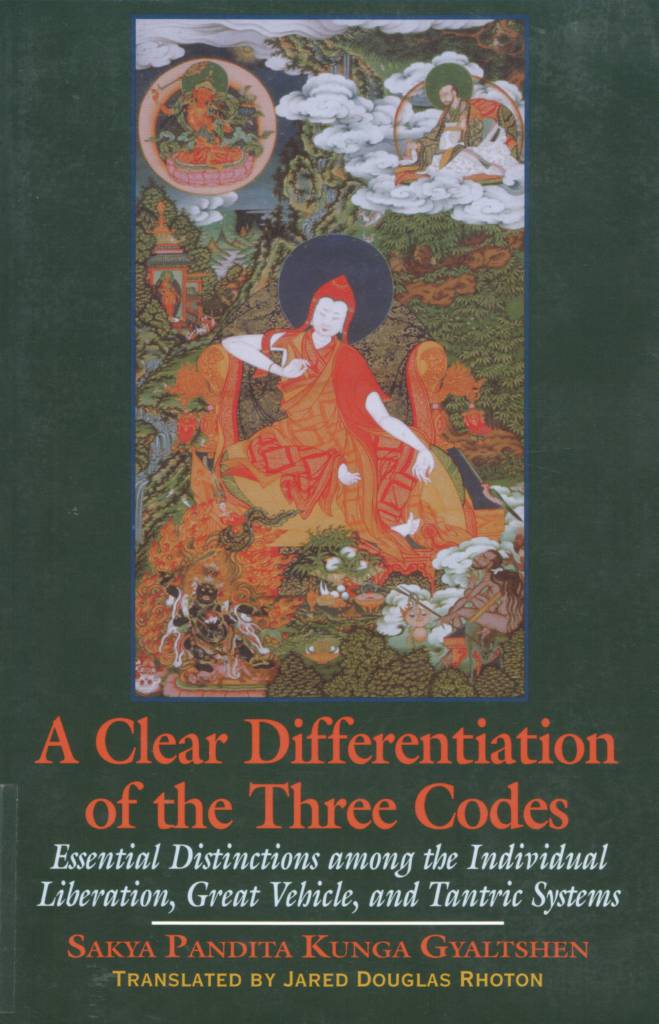A Clear Differentiation of the Three Codes
No edit summary |
No edit summary |
||
| Line 12: | Line 12: | ||
Whatever one may conclude about the correctness of Sakya Pandita's opinions on any given topic, there can be no doubt that by raising so many questions so trenchantly, Sapan roused Tibetan Buddhists from doctrinal complacency and contributed mightily to the formation of the remarkable intellectual culture that has long distinguished the Buddhist monastic colleges of Tibet. It is for this reason that Sakya Pandita is remembered as the first of the three great thinkers renowned in Central Tibet as emanations of Mañjuśrī, the Bodhisattva of Wisdom. The two who followed him-the great Dzokchen master Longchen Rabjampa (1308-1364) and the peerless scholar and adept Je Tsongkhapa (1357-I419)-were themselves indebted to Sakya Pandita in myriad ways. | Whatever one may conclude about the correctness of Sakya Pandita's opinions on any given topic, there can be no doubt that by raising so many questions so trenchantly, Sapan roused Tibetan Buddhists from doctrinal complacency and contributed mightily to the formation of the remarkable intellectual culture that has long distinguished the Buddhist monastic colleges of Tibet. It is for this reason that Sakya Pandita is remembered as the first of the three great thinkers renowned in Central Tibet as emanations of Mañjuśrī, the Bodhisattva of Wisdom. The two who followed him-the great Dzokchen master Longchen Rabjampa (1308-1364) and the peerless scholar and adept Je Tsongkhapa (1357-I419)-were themselves indebted to Sakya Pandita in myriad ways. | ||
[[File:A Clear Differentiation of the Three Codes-front.jpg]] | |||
MATTHEW T. KAPSTEIN | MATTHEW T. KAPSTEIN | ||
Editor, SUNY Buddhist Studies Series | Editor, SUNY Buddhist Studies Series | ||
Revision as of 15:46, 14 April 2020
A Clear Differentiation of the Three Codes presents the first English translation of the sDom gsum rab dbye, one of the most famous and controversial doctrinal treatises of Tibetan Buddhism. Written by Sakya Pandita Kunga Gyaltshen (1182–1251), a founder of the Sakya school and one of Tibet’s most learned sages, The Three Codes strongly influenced subsequent religious and intellectual traditions in Tibet—and sparked a number of long-lasting doctrinal and philosophical disputes, some of which persist today.
In The Three Codes, Sakya Pandita discusses the Hinayana, Mahayana, and Tantric vows of Buddhist conduct, which often diverge and contradict each other. He criticizes, on at least one point or another, later practitioners of almost every lineage, including the Kadampa, Kagyupa, and Nyingmapa, for contradicting the original teachings of their own traditions. (Source: SUNY Press)
| Citation | Rhoton, Jared Douglas, trans. A Clear Differentiation of the Three Codes: Essential Distinctions among the Individual Liberation, Great Vehicle, and Tantric Systems. Edited by Victoria R. M. Scott. SUNY Series in Buddhist Studies. Albany: State University of New York Press, 2002. |
|---|---|




